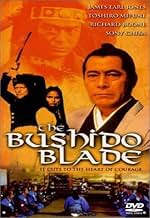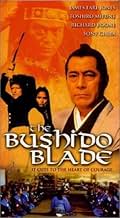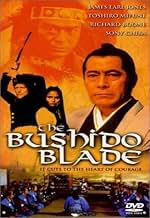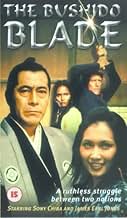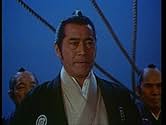A steel samurai blade that was to be given to the American ambassador by the Emperor of Japan is stolen. American sailors and Japanese samurai are sent to find it.A steel samurai blade that was to be given to the American ambassador by the Emperor of Japan is stolen. American sailors and Japanese samurai are sent to find it.A steel samurai blade that was to be given to the American ambassador by the Emperor of Japan is stolen. American sailors and Japanese samurai are sent to find it.
Mike Starr
- Bos'n Cave Johnson
- (as Michael Starr)
Timothy Patrick Murphy
- Midshipman Robin Burr
- (as Timothy Murphy)
Shin'ichi Chiba
- Prince Ido
- (as Sony Chiba)
Hitoshi Ômae
- Sumo
- (as Kin Omai)
- Director
- Writer
- All cast & crew
- Production, box office & more at IMDbPro
Featured reviews
Great cast. Too bad the rest of it couldn't match up.
Richard Boone plays a growling Cmmdr. Perry in his last role. And REALLY chews it up.
Frank (Coronet Blue) Converse (The real star) attempts to be an action hero. Not enough action though. And He's a little wooden.
Any Asian actor with a name dropped by for a cameo. Seeing the late, great Toshiro Mifune reprise most of his previous samurai roles was nice. And Sonny Chiba's warrior cliché is something I never get tired of. Then there's Mako as the cliché' wise man.
Laura (GODDESS) Gemser showing up made it worth the price of a rental. (To me anyway. She is GORGEOUS.) Seeing a young Mike Starr was kind of cool. He was obviously meant to be comedy relief.
James Earl Jones role should have been larger. Is this film still cut? An adventure story about finding a stolen sword could have and should have been a lot better.
And that minstrel show on the ship might anger a few people...even if it is based on facts of the times.
Not a waste...not unmissable either.
Richard Boone plays a growling Cmmdr. Perry in his last role. And REALLY chews it up.
Frank (Coronet Blue) Converse (The real star) attempts to be an action hero. Not enough action though. And He's a little wooden.
Any Asian actor with a name dropped by for a cameo. Seeing the late, great Toshiro Mifune reprise most of his previous samurai roles was nice. And Sonny Chiba's warrior cliché is something I never get tired of. Then there's Mako as the cliché' wise man.
Laura (GODDESS) Gemser showing up made it worth the price of a rental. (To me anyway. She is GORGEOUS.) Seeing a young Mike Starr was kind of cool. He was obviously meant to be comedy relief.
James Earl Jones role should have been larger. Is this film still cut? An adventure story about finding a stolen sword could have and should have been a lot better.
And that minstrel show on the ship might anger a few people...even if it is based on facts of the times.
Not a waste...not unmissable either.
My review was written in January 1982 after a screening at Manhattan's Lyric theatre on 42nd St.:
Filmed in Japan using the facilities of Toho Studios in 1978, "The Bushido Blade" is an unexciting hybrid, using British financing, U. S. production and international casting. A forerunner of John Frankenheimer's new "The Challenge", "Blade" has already played cable-tv domestically before current booking under hasty title: "The Bloody Bushido Blade".
Period piece's plot (convoluted but unfolding in "Classics Illustrated" style) is concerned with Commodore Perry (Richard Boone) in Yokohama in 1854 opening diplomatic relations with Japan by signing a treaty with the Shogun. Hangup in the signing process is that the Shogun's gift to the U. S. president (title sword) has been stolen, and the Japanese, in particular the Shogun's commander (Toshiro Mifune), will lose face unless it is recovered.
Prince Edo (Sonny Chiba) sets out to retrieve the blade from rebel leader Lord Yamato (Tetsuro Tamba), with various U. S. sailors and their local helpers tagging along. By film's anticlimactic ending, marine Captain Hawk (Frank Converse) has been made an honorary samurai, and he and femme samurai Laura Gemser have zapped everybody in sight.
Though there is nudity and beheadings for the action trade, film plays more like a kiddie picture, with cardboard heroes, old-fashioned romance, and good versus evil. Acting ranges from the hammy (hand-waving and shouting by the late Richard Boone) to the animation of a plank of mahogany (B-film sex symbol Laura Gemser). Underutilization of name talent is irritating, with action star Sonny Chiba written out of most of the picture and James Earl Jones given an extraneous walk-on. Leading player Frank Converse is okay, but most fans will want him to make way for the more mythic types.
Low budget is obvious in lousy model shots to represent Perry's fleet and an absurd finale where Converse and chubby helper Michael Starr push over a flaming wood lighthouse to crush and burn Yamato's oddly unobservant samurai warriors. Many have tried to bring East and West together on film (e.g., John Boorman's "Hell in the Pacific" and Terence Young's "Red Sun") with usually phony results, the one constant factor being Mifunes' presence in the cast. He shows up once more in "Bushido Blade" (and yet again in "The Challenge"), but the material lets him and the viewer down.
Period piece's plot (convoluted but unfolding in "Classics Illustrated" style) is concerned with Commodore Perry (Richard Boone) in Yokohama in 1854 opening diplomatic relations with Japan by signing a treaty with the Shogun. Hangup in the signing process is that the Shogun's gift to the U. S. president (title sword) has been stolen, and the Japanese, in particular the Shogun's commander (Toshiro Mifune), will lose face unless it is recovered.
Prince Edo (Sonny Chiba) sets out to retrieve the blade from rebel leader Lord Yamato (Tetsuro Tamba), with various U. S. sailors and their local helpers tagging along. By film's anticlimactic ending, marine Captain Hawk (Frank Converse) has been made an honorary samurai, and he and femme samurai Laura Gemser have zapped everybody in sight.
Though there is nudity and beheadings for the action trade, film plays more like a kiddie picture, with cardboard heroes, old-fashioned romance, and good versus evil. Acting ranges from the hammy (hand-waving and shouting by the late Richard Boone) to the animation of a plank of mahogany (B-film sex symbol Laura Gemser). Underutilization of name talent is irritating, with action star Sonny Chiba written out of most of the picture and James Earl Jones given an extraneous walk-on. Leading player Frank Converse is okay, but most fans will want him to make way for the more mythic types.
Low budget is obvious in lousy model shots to represent Perry's fleet and an absurd finale where Converse and chubby helper Michael Starr push over a flaming wood lighthouse to crush and burn Yamato's oddly unobservant samurai warriors. Many have tried to bring East and West together on film (e.g., John Boorman's "Hell in the Pacific" and Terence Young's "Red Sun") with usually phony results, the one constant factor being Mifunes' presence in the cast. He shows up once more in "Bushido Blade" (and yet again in "The Challenge"), but the material lets him and the viewer down.
The picture develops the true tale of commandant Perry (Richard Boone's final show) -along with his underlings- who during the nineteenth century is sent by the US President to Japan to serve as the first U.S. As in 1852 , Perry was assigned a mission by American President Millard Fillmore to force the opening of Japanese ports to American trade , through the use of gunboat diplomacy if necessary Consul-General to that country . Perry (considered father of the Steam Navy) finally reached Uraga at the entrance to Edo Bay in Japan on July 8 , 1853 . In the meantime , the Japanese government was paralyzed due to the incapacitation by illness of Shogun Tokugawa Ieyoshi and by political indecision on how to handle the unprecedented threat to the nation's capital . Later on , a steel samurai blade that was to be given by the Japanese high authority (Toshiro Mifune) to the American ambassador from the Emperor of Japan is stolen . After that , American sailors : Bos'n Cave Johnson (Mike Starr), Midshipman Robin Burr (Timothy Patrick Murphy) , Captain Lawrence (Frank Converse) and Japanese samurai (Sonny Chiba) are sent to find it . They discover enormous hostility to foreigners, as well as dangers and risks . There Robin finds romance with a gorgeous girl and Captain Lawrence meets a samurai woman (Laura Gemser) . Meanwhile , they confront the Shogun army , and Lord Yamato (Tetsurô Tanba) . The Japanese attackers follow the Bushido code , it means honor but also revenge , bloodshed and violent death! . The Bushido blade cuts to the heart of courage .
Richard Boone becomes the first Ambassador from the Western world is this oriental adventure . The film deals with conflicts between the radical conservatism and modernism ; upon relation of the West and East World . In addition , a sweeping , human drama with all the ingredients : adventures , betrayal , romance , inter-racial love story , emotions , breathtaking battles , spellbound scenarios and results to be pretty interesting . Stunning images illuminate the full-blown feats of a bunch of sailors under impressive Japanese sets . It's an acceptable epic in medium budget , including an agreeable statement about honor , tradition and futility of war . Glimmer and colorfully cinematography shot on location in London , England, UK and Tokyo , Japan ; though a perfect remastering is necessary . Evocative and appropriate score , including a catching leitmotif , by Maury Laws . Panned by the critics , the movie was a flop at box office in USA , receiving awful reviews . However , nowadays is best deemed . The motion picture was professionally directed by Tom Kotani , though it has some gaps as well as flaws and uneven pacing .
This costumer picture is based on historic events . As Perry returned in 1854 with ten ships and 1600 men and he carried out the Opening of Japan , as called The Perry Expedition: 1852–1854 . After initial resistance by the Japanese , Perry was permitted to land at Kanagawa, near the site of present-day Yokohama where after negotiations lasting for around a month , the Convention of Kanagawa . Perry signed as American plenipotentiary, and Akira signed for the Japanese side. Perry departed , mistakenly believing the agreement had been made with imperial representatives , not understanding the true position of the Shogun, the de facto ruler of Japan . As Japan was dominated for a dynasty occupied by the Togugawa family from century XVI until 1868 and characterized by ruling ¨Daimios ¨ , confronting occidental people and shunning the opening imposed by Admiral Perry in 1863 ; he was the first foreigner in Japan who undergoes a culture shock . Being dead emperor Komei , succeeded in 1867 , Mutsu Hito , one time crowned as emperor Meiji , he abolished the Shogun . Matsu Hito carried out various changes, as a liberal cabinet , creating a Duma or Parliament and following actual models and modern spirit . Anti-reforms riots to return old values , traditional way of life and code Bushido were realized by the Samurais a type of medieval knight for preventing of occidental life style . These events have been developed in various films as ¨Barbarian and Geisha¨ by John Huston , considering John Wayne is horribly miscast that resulted to be one of the worst of his bad films , ¨The last Samurai¨ by Edward Zwick with Tom Cruise , Ken Watanabe , Billy Connolly , Tony Goldwyn and the magnificent TV series ¨Shogun¨ (1980) with Richard Chamberlain . Although ¨The Bushido blade¨ was derided as an attempt to copy the hit TV mini-series "Shogun", it was actually made in 1980, before "Shogun", though it wasn't released until after that series had aired .
Richard Boone becomes the first Ambassador from the Western world is this oriental adventure . The film deals with conflicts between the radical conservatism and modernism ; upon relation of the West and East World . In addition , a sweeping , human drama with all the ingredients : adventures , betrayal , romance , inter-racial love story , emotions , breathtaking battles , spellbound scenarios and results to be pretty interesting . Stunning images illuminate the full-blown feats of a bunch of sailors under impressive Japanese sets . It's an acceptable epic in medium budget , including an agreeable statement about honor , tradition and futility of war . Glimmer and colorfully cinematography shot on location in London , England, UK and Tokyo , Japan ; though a perfect remastering is necessary . Evocative and appropriate score , including a catching leitmotif , by Maury Laws . Panned by the critics , the movie was a flop at box office in USA , receiving awful reviews . However , nowadays is best deemed . The motion picture was professionally directed by Tom Kotani , though it has some gaps as well as flaws and uneven pacing .
This costumer picture is based on historic events . As Perry returned in 1854 with ten ships and 1600 men and he carried out the Opening of Japan , as called The Perry Expedition: 1852–1854 . After initial resistance by the Japanese , Perry was permitted to land at Kanagawa, near the site of present-day Yokohama where after negotiations lasting for around a month , the Convention of Kanagawa . Perry signed as American plenipotentiary, and Akira signed for the Japanese side. Perry departed , mistakenly believing the agreement had been made with imperial representatives , not understanding the true position of the Shogun, the de facto ruler of Japan . As Japan was dominated for a dynasty occupied by the Togugawa family from century XVI until 1868 and characterized by ruling ¨Daimios ¨ , confronting occidental people and shunning the opening imposed by Admiral Perry in 1863 ; he was the first foreigner in Japan who undergoes a culture shock . Being dead emperor Komei , succeeded in 1867 , Mutsu Hito , one time crowned as emperor Meiji , he abolished the Shogun . Matsu Hito carried out various changes, as a liberal cabinet , creating a Duma or Parliament and following actual models and modern spirit . Anti-reforms riots to return old values , traditional way of life and code Bushido were realized by the Samurais a type of medieval knight for preventing of occidental life style . These events have been developed in various films as ¨Barbarian and Geisha¨ by John Huston , considering John Wayne is horribly miscast that resulted to be one of the worst of his bad films , ¨The last Samurai¨ by Edward Zwick with Tom Cruise , Ken Watanabe , Billy Connolly , Tony Goldwyn and the magnificent TV series ¨Shogun¨ (1980) with Richard Chamberlain . Although ¨The Bushido blade¨ was derided as an attempt to copy the hit TV mini-series "Shogun", it was actually made in 1980, before "Shogun", though it wasn't released until after that series had aired .
Way back in 1980, I saw "The Bushido Blade" as a late night premiere on CBS. Much younger then, I was fairly impressed with the romance and action and the film was fondly remembered over the decades.
25 years later, the film comes out in DVD and I had to get it.
Well...
My disappointment was palpable. Richard Boone gives a loud, obnoxious performance as Commodore Matthew Perry, top billed James Earl Jones, while in fine voice and shape, only appears for about 2 minutes of screen time. The rugged Frank Converse comes off fairly well, but I can't understand why a Japanese actress was not cast as Tomoe instead of Laura Gemser. Sonny Chiba and Mako make good impressions, but something's not right when Mayumi Asano, playing Yuki, gives the best performance in the film. And this, with virtually no dialog. But, perhaps, that explains it right there.
Poorly written by William Overgard, a Rankin-Bass in-house hack, the story, beginning with an offensive minstrel show, is about the search by American sailors for a stolen ceremonial samurai sword, meant as a gift for the President of the United States in 1854 Japan. The three Americans are aided in their search by noble samurai Chiba and half-caste warrior Gemser. What bothers me most is the lack of any texture in the story. Most scenes take place against utilitarian sets with no detail. The countryside, where most of what passes as action takes place, is flatly filmed. Worst of all, none of the local Japanese have any significant dialog, and surprisingly, have no involvement in the story, but, act only as background color for the three or four major characters. Very strange. I think there are less than 10 speaking roles and half of those are of the "Yes, Sir. No, Sir" variety from extras.
After some disappointing samurai battle action over the sword against a lord and his poorly trained army of warriors...it just ends. You might be surprised by the suddenness of the fade out, but, that's all there is. I understand there is an alternate version running about 10 minutes longer, but, besides an extended ending, I can't imagine what might be missing or added to improve things. In retrospect, viewing the film after so many years brought back certain story reservations I had even as a youngster. Plot holes abound and the final fate of the sword and it's pursuers is not ironic as intended, but just leaves a bad taste in your mouth.
25 years later, the film comes out in DVD and I had to get it.
Well...
My disappointment was palpable. Richard Boone gives a loud, obnoxious performance as Commodore Matthew Perry, top billed James Earl Jones, while in fine voice and shape, only appears for about 2 minutes of screen time. The rugged Frank Converse comes off fairly well, but I can't understand why a Japanese actress was not cast as Tomoe instead of Laura Gemser. Sonny Chiba and Mako make good impressions, but something's not right when Mayumi Asano, playing Yuki, gives the best performance in the film. And this, with virtually no dialog. But, perhaps, that explains it right there.
Poorly written by William Overgard, a Rankin-Bass in-house hack, the story, beginning with an offensive minstrel show, is about the search by American sailors for a stolen ceremonial samurai sword, meant as a gift for the President of the United States in 1854 Japan. The three Americans are aided in their search by noble samurai Chiba and half-caste warrior Gemser. What bothers me most is the lack of any texture in the story. Most scenes take place against utilitarian sets with no detail. The countryside, where most of what passes as action takes place, is flatly filmed. Worst of all, none of the local Japanese have any significant dialog, and surprisingly, have no involvement in the story, but, act only as background color for the three or four major characters. Very strange. I think there are less than 10 speaking roles and half of those are of the "Yes, Sir. No, Sir" variety from extras.
After some disappointing samurai battle action over the sword against a lord and his poorly trained army of warriors...it just ends. You might be surprised by the suddenness of the fade out, but, that's all there is. I understand there is an alternate version running about 10 minutes longer, but, besides an extended ending, I can't imagine what might be missing or added to improve things. In retrospect, viewing the film after so many years brought back certain story reservations I had even as a youngster. Plot holes abound and the final fate of the sword and it's pursuers is not ironic as intended, but just leaves a bad taste in your mouth.
"A swashbuckling Samurai saga that beats SHOGUN!" - Star Bulletin
Now, I bought a copy of this motion picture on video cassette that was released by Thorn-EMI Video, which means that the violence, beheadings, blood, and nudity are all intact as opposed to edited in the TV broadcast version.
The reason why I purchased it: I needed a test tape for VCR repair. For one dollar, you get an old tape where you wouldn't care if the machine decided to eat it!
Anyways, since I bought the tape and have also seen Shogun before, I figured I would give it a whurl. I have watched this movie and I'm glad I only spent one dollar on it!
While the premise of the story is certainly interesting enough, the low budget and TV-like production values doesn't do the premise any justice at all.
The acting feels badly forced at many points, which is also coupled with some rather claustrophobic cinematography, nervous direction, and snapshot editing. (It felt like I was watching a TV show that seemed to almost feel like "Hawaii Five-O" with all the pointless and quick zoom-ins to objects in the frame.)
The pacing felt somewhat uneven, perhaps to where it was trying to rush the story forward to reach the end sooner. This might explain the 92 minutes runtime on something that might have required up to 150 minutes to properly play in order to account for character relation to each other and their settings. In contrast, Paramount wisely produced Shogun as a television miniseries, as the original novel could simply not be condensed to even a four hour epic without losing too much. (Although, the re-editing of the miniseries with only a small helping of new footage in an attempt to make a motion picture out of Shogun was a very bad idea.)
There didn't seem to be very good interplay between the characters. The relationships that you may see develop in this picture tend to develop rather quickly and, therefore, unrealistically. The characters also seem somewhat simple and, in many ways, unbelievable. In concert with the atrocious acting, it made watching the characters about as appealing as watching a bad sci-fi movie without MST3K. In contrast, Shogun had characters that developed intricate interplay over a long period of time. They had shown themselves as complex individuals and continued to develop in the settings and with the other characters throughout the story.
Also, the one thing that caught me totally off-guard was the production company: Rankin-Bass.
Now, Rankin-Bass is a production company that is primarily responsible for children's programming. They had produced the animated version of "The Hobbit," "The Last Unicorn (1980s, ITC)," and "The King and I (1999, Warner Bros)," as well as producing various Christmas specials in the 1960s and 1970s like "Frosty, the Snowman" (Need to get to the north pole before melting), "Rudolph the Red Nosed Reindeer" (I don't want to wear a lump of coal on my nose!), "Little Drummer Boy," and "T'was the night before Christmas" (You know, the one with the singing clock to make Santa forgive a city for a letter written by some mouse who used "long words."). To those familiar with the 1980s, Rankin-Bass was also responsible for "Thundercats" and "Silverhawks."
Now, this did give a reason why the movie sucked as a whole: a production company with experience only with children's entertainment cannot hope to produce an R rated picture without creative difficulty.
Now, even though this film was co-produced with a British firm: Trident Films, the producer was Arthur Rankin Jr. himself. Jules Bass apparently did not have any involvement with this production.
Watch out for a cameo by James Earl Jones. Mako, Toshiro Mufune (who played in Shogun as well), and Sonny Chiba are other well regarded actors who starred in this movie.
If anything, try it for a rental and watch for yourself. This is assuming your local video store even has this movie for rent.
This movie does deserve some credit for at least trying to maintain a standard, although I would only give it one and half stars.
I might have given it worse, but watching REAL garbage like "Space Mutiny" and "Strategic Command" does make "Bushido Blade" and even "Xanadu" look decent. - Reinhart
Now, I bought a copy of this motion picture on video cassette that was released by Thorn-EMI Video, which means that the violence, beheadings, blood, and nudity are all intact as opposed to edited in the TV broadcast version.
The reason why I purchased it: I needed a test tape for VCR repair. For one dollar, you get an old tape where you wouldn't care if the machine decided to eat it!
Anyways, since I bought the tape and have also seen Shogun before, I figured I would give it a whurl. I have watched this movie and I'm glad I only spent one dollar on it!
While the premise of the story is certainly interesting enough, the low budget and TV-like production values doesn't do the premise any justice at all.
The acting feels badly forced at many points, which is also coupled with some rather claustrophobic cinematography, nervous direction, and snapshot editing. (It felt like I was watching a TV show that seemed to almost feel like "Hawaii Five-O" with all the pointless and quick zoom-ins to objects in the frame.)
The pacing felt somewhat uneven, perhaps to where it was trying to rush the story forward to reach the end sooner. This might explain the 92 minutes runtime on something that might have required up to 150 minutes to properly play in order to account for character relation to each other and their settings. In contrast, Paramount wisely produced Shogun as a television miniseries, as the original novel could simply not be condensed to even a four hour epic without losing too much. (Although, the re-editing of the miniseries with only a small helping of new footage in an attempt to make a motion picture out of Shogun was a very bad idea.)
There didn't seem to be very good interplay between the characters. The relationships that you may see develop in this picture tend to develop rather quickly and, therefore, unrealistically. The characters also seem somewhat simple and, in many ways, unbelievable. In concert with the atrocious acting, it made watching the characters about as appealing as watching a bad sci-fi movie without MST3K. In contrast, Shogun had characters that developed intricate interplay over a long period of time. They had shown themselves as complex individuals and continued to develop in the settings and with the other characters throughout the story.
Also, the one thing that caught me totally off-guard was the production company: Rankin-Bass.
Now, Rankin-Bass is a production company that is primarily responsible for children's programming. They had produced the animated version of "The Hobbit," "The Last Unicorn (1980s, ITC)," and "The King and I (1999, Warner Bros)," as well as producing various Christmas specials in the 1960s and 1970s like "Frosty, the Snowman" (Need to get to the north pole before melting), "Rudolph the Red Nosed Reindeer" (I don't want to wear a lump of coal on my nose!), "Little Drummer Boy," and "T'was the night before Christmas" (You know, the one with the singing clock to make Santa forgive a city for a letter written by some mouse who used "long words."). To those familiar with the 1980s, Rankin-Bass was also responsible for "Thundercats" and "Silverhawks."
Now, this did give a reason why the movie sucked as a whole: a production company with experience only with children's entertainment cannot hope to produce an R rated picture without creative difficulty.
Now, even though this film was co-produced with a British firm: Trident Films, the producer was Arthur Rankin Jr. himself. Jules Bass apparently did not have any involvement with this production.
Watch out for a cameo by James Earl Jones. Mako, Toshiro Mufune (who played in Shogun as well), and Sonny Chiba are other well regarded actors who starred in this movie.
If anything, try it for a rental and watch for yourself. This is assuming your local video store even has this movie for rent.
This movie does deserve some credit for at least trying to maintain a standard, although I would only give it one and half stars.
I might have given it worse, but watching REAL garbage like "Space Mutiny" and "Strategic Command" does make "Bushido Blade" and even "Xanadu" look decent. - Reinhart
Did you know
- TriviaAlthough this film was derided as an attempt to copy the hit TV mini-series Shogun (1980), it was actually made in 1978, before Shogun (1980), though it wasn't released until after that series had aired.
- Crazy creditsThe producers gratefully acknowledge the cooperation of Toho Studios staff and personnel in the production of this picture.
- Alternate versionsFirst shown in USA in a 92-minute version on cable television, prior to a theatrical release in the USA of the complete 104-minute version, this retitled "The Bloody Bushido Blade."
- ConnectionsFeatured in Vintage Video: 0249 The Bushido Blade (1981) (2021)
- How long is The Bushido Blade?Powered by Alexa
Details
Contribute to this page
Suggest an edit or add missing content




